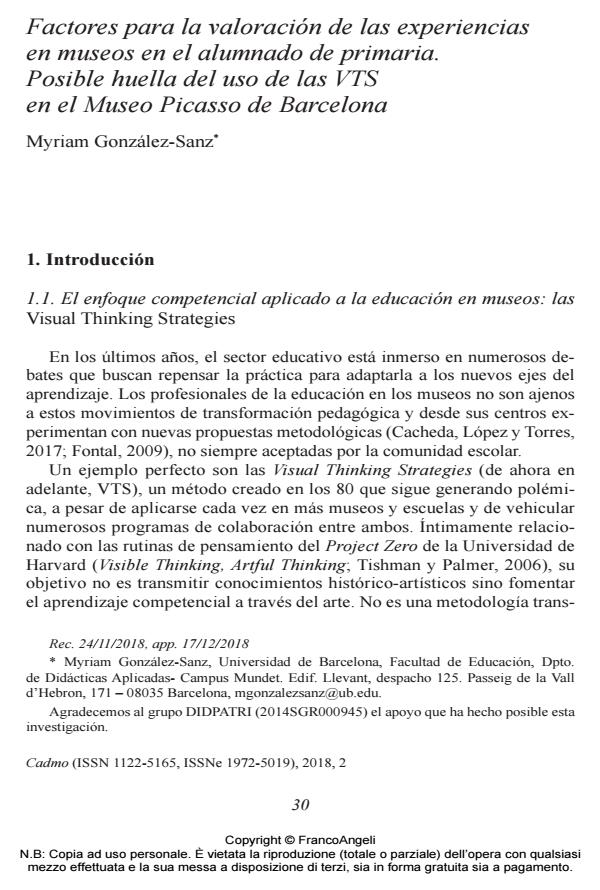Factors related to museum experience assessments among elementary school students. Does the use of Visual Thinking Strategies in Barcelona’s Picasso Museum make an impression?
Journal title CADMO
Author/s Myriam González-Sanz
Publishing Year 2019 Issue 2018/2
Language Spanish Pages 17 P. 30-46 File size 501 KB
DOI 10.3280/CAD2018-002003
DOI is like a bar code for intellectual property: to have more infomation
click here
Below, you can see the article first page
If you want to buy this article in PDF format, you can do it, following the instructions to buy download credits

FrancoAngeli is member of Publishers International Linking Association, Inc (PILA), a not-for-profit association which run the CrossRef service enabling links to and from online scholarly content.
The present study analyses elementary school student insights of two school field trips to museums. Students were asked to assess their visit to the Picasso Museum in Barcelona (MPB), where the Visual Thinking Strat egies (VTS) teaching method was applied, and a previous non-VTS visit to another museum. Two items from a student survey were analyzed using quantitative and qualitative content-analysis techniques, in order to determine which aspects were related to positive or negative museum assessments and potential differences between the two visit types. The findings show that a large majority of students positively assessed both museum experiences, with the categories fun, interest, and collection resulting the most salient. Nevertheless, in the MPB students placed importance on the use of VTS and more emphasis on the visit as a learning experience. It is evident that the VTS method made an impression on students, even though some aspects generated controversy among the participants.
Keywords: Heritage education; museum; elementary education; student satisfaction; visual thinking strategies.
- THE INFLUENCE OF SELF-ASSESSMENT ACTIVITIES ON STUDENT LEARNING OUTCOMES Gregorio Sánchez-Marín, María Encarnación Lucas-Pérez, Antonio José Carrasco-Hernández, Gabriel Lozano-Reina, Catalina Nicolás-Martínez, in Journal of Management and Business Education /2018 pp.28
DOI: 10.35564/jmbe.2018.0003 - EVALUACIÓN DE LA IMPLANTACIÓN DE APRENDIZAJE BASADO EN PROYECTOS COMO HERRAMIENTA PARA EL ESTUDIO DE LA ECONOMÍA DE LA EMPRESA Almudena Macías Guillén, Miguel Ángel Sánchez de Lara, Miguel Prado Román, in Journal of Management and Business Education /2018 pp.190
DOI: 10.35564/jmbe.2018.0014 - What Type of Learning Methods do Pupils Prefer in Museums and at School? Elementary School Pupil’s Perceptions of Visual Thinking Strategies as Applied at the Barcelona Picasso Museum Myriam González-Sanz, Ann E. Wilson-Daily, Maria Feliu-Torruella, Alex Ibanez-Etxeberria, in Sage Open 21582440231209690/2023
DOI: 10.1177/21582440231209690
Myriam González-Sanz, Factores para la valoración de las experiencias en museos en el alumnado de primaria. Posible huella del uso de las VTS en el Museo Picasso de Barcelona in "CADMO" 2/2018, pp 30-46, DOI: 10.3280/CAD2018-002003